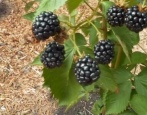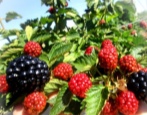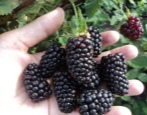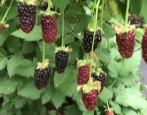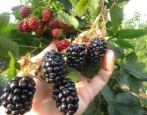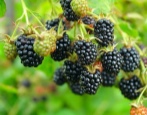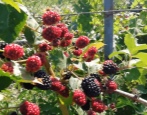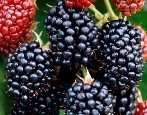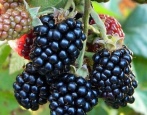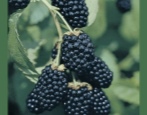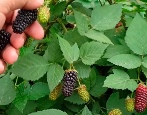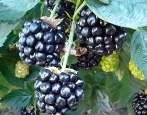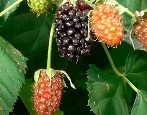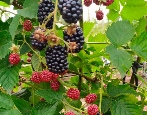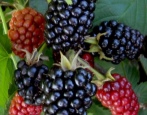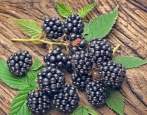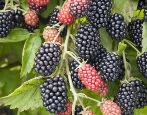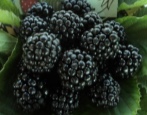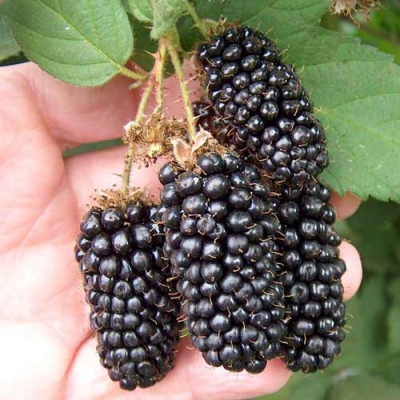
- Authors: San Francisco, Oregon, America
- Taste: sweet with sourness
- Scent : strong, rich
- The presence of thorns: No
- Berry weight, g: 5-8 g
- Berry size: medium and large
- Berry color: bright black, glossy
- Fruiting period: mid June - early August, fruiting lasts about 4 weeks
- Yield: up to 35 kg per bush
- Frost resistance, ° C / Winter hardiness: winter hardy, -27 ... -30 ° С
Black Diamond BlackBerry can be found today on the plots of both professional and amateur gardeners. It has become popular due to its good yield and excellent taste.
Breeding history of the variety
The described variety appeared in America, San Francisco. From here, Black Diamond went all over the world.
Description of the variety
Blackberries of the described species have become in demand due to their good keeping quality. After harvesting, the berry retains its presentation for 10 days.
This type is also known as the Black Diamond. The berry has a universal purpose.
Bushes are formed upright. Black Diamond can be described as moderately vigorous. Shoots are formed tall, flexible, semi-creeping. Their length can reach 200 cm. The bushes grow up to 3 meters high. One of the advantages is the absence of thorns on the shoots.
Ripening terms
Blackberries bloom in May. The fruiting period begins in mid-June and lasts until August. Delicious berries can be enjoyed for about 4 weeks.
The variety is early in maturity.
Growing regions
Black Diamond can be successfully grown both in the south of the country and in the Urals, in the Moscow region and other regions with a temperate climate.
Yield
As for the yield, it is possible to collect up to 35 kilograms of berries from the bush with careful plant care. The yield is high.
Berries and their taste
The berries have an attractive, rich, glossy black shade. They are characterized by a sweet taste with a slight acidity and firm, juicy pulp. As for the aroma, it is intense, blackberry.
On the bushes there are large and medium-sized fruits. Their weight can reach 5-8 grams.
Growing features
The following types of soil are suitable for growing:
black soil;
loam;
sandy soil.
In the latter case, you will have to constantly use fertilizers.
Site selection and soil preparation
The place for planting is necessarily sunny or partial shade, otherwise the quality of the berries will deteriorate. It is important to maintain a distance of 1 meter between the bushes. Planting depth of seedlings is 500 mm.
The berries are planted in a pre-prepared pit, the dimensions of which are 40x40x40 cm.In order not to add fertilizing in the first two years, before laying the planting material, it is worth putting a nutrient mixture of compost, potassium salt and superphosphate in the amount of 1000, 50 and 100 g, respectively, on the bottom. All components are mixed, poured into a pit and sprinkled with fertile soil.
To make it easier for the plant to stretch upward, they put a trellis next to it. It is better if the shoot is located on the support in a zigzag manner.
In the event that the planting of the material is planned for the fall, the preparatory work is carried out 14 days before planting. Areas to be planted in spring are prepared in autumn.
Watering and feeding
The gardener cannot do without regular watering. One bush, which is already several years old, should take up to two buckets of water per week.
In the first year, fertilizing with potassium and calcium is mandatory. In the fall, complex fertilizers are well suited.They must include:
iron;
zinc;
boron and other trace elements.
From organic fertilizers, you can use horse manure, chicken manure, ash.
Frost resistance and preparation for winter
It is worth saying that the variety in question is frost-resistant. Its frost resistance index is from –27 to –30 degrees. Thus, in the southern region, the covering material is not used, but in the northern regions, you can simply cover the bushes after pruning with coniferous spruce branches.
Diseases and pests
Black Diamond is highly resistant to insect attacks and diseases, especially anthracnose and gray rot. However, preventive treatment with copper sulfate, fungicides, garlic infusion allows you to keep young seedlings and adult plants healthy.
Reproduction
The variety can be propagated in several ways:
root the tops;
plant green or woody shoots;
divide the bush.


